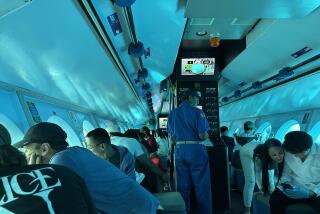Submarine Crew Goes Full Speed Ahead Into the Past : Reunion: Men of the USS Guardfish recall their service and camaraderie in the Pacific during World War II. ‘It was the high point of my life,’ one says.
- Share via
LONG BEACH — They were young men, hardly more than boys, when they set out on what was for many the greatest adventure of their lives: submarine duty in the Pacific in World War II. Now, half a century later, they are old men, in their late 60s and 70s, with old men’s faces.
But when the men of the submarine USS Guardfish got together last week for a reunion at the Long Beach Naval Station on Terminal Island, the decades seemed to drop away. Wrinkles seemed to fade, backs seemed to straighten, old eyes seemed to twinkle with youth.
For one night, at least, the men of the Guardfish were young again.
“It was the high point of my life,” John Holden, 74, said of his service as a gunner’s mate on the Guardfish. “It was one time that I really got to feel like I was doing more than just my share.”
It was a sentiment shared by most of the 43 former crew members at the reunion, which was held in conjunction with the annual U.S. Submarine Veterans of World War II convention in Anaheim.
Commissioned in May, 1942, the Guardfish was 311 feet long and had a crew of about 70. Its active service life was short but glorious. In 12 tours of duty in enemy waters, it won two coveted Presidential Unit Citations, sank scores of enemy ships, performed secret reconnaissance missions off the coast of Japan and elsewhere, rescued downed American fliers and endured numerous depth-charge attacks. Its exploits formed the basis of the 1943 film “Destination Tokyo,” with Cary Grant and John Garfield.
It was dangerous duty, but the Guardfish was one of the lucky boats. (In the Navy, a submarine is called a boat, not a ship.) Of 309 U.S. submarines that served in World War II, 52 never returned; as submariners put it, the boats are “still on patrol.” About 15,000 Americans were members of the “silent service” in World War II; of them, about 3,500 lost their lives, one of the highest casualty rates of any service.
Submariners’ impact on the Pacific theater of the war was tremendous. Although few in numbers compared to other Navy branches, the submariners accounted for more than 60% of Japanese maritime losses, denying the enemy supplies and sea lanes.
But that was the big picture. For the Guardfish veterans at the boat’s 39th annual reunion, it was the small things, the individual operations and actions, that they seemed to remember best.
For John Holden, who joined the Navy shortly after Pearl Harbor, the most vivid memory was of the Guardfish sneaking into enemy waters off the island of Bougainville and using rubber rafts to rescue more than 100 people--downed fliers, Australian “coast watchers” and island scouts and their families--who were one step ahead of the Japanese forces.
“It was a harrowing experience,” said Holden, a Ventura resident. “But it was a very satisfying thing.”
Frank Medina, 69, an Arizonan who joined the Navy at 18 and handled torpedoes aboard the Guardfish, remembers undergoing half a day of continuous depth-charge attacks by Japanese destroyers off the coast of Japan in 1942.
“I always remember the captain, Capt. (Thomas) Klakring,” said Medina, an Anaheim resident. “I remember being surprised that a man could be so damned brave.”
Claude Conner, 67, a retired electronics engineer from Rancho Cucamonga, remembers a glove. The Guardfish was on surface patrol off Japan when a Japanese plane suddenly appeared, jarring the submarine captain into ordering an emergency dive. A lookout’s glove got caught in the upper hatch, and water began filling the observation tower where Conner was stationed.
“I remember thinking, ‘That’s it, I’m dead,’ ” Conner said. He wasn’t; the sub resurfaced in time. But despite that and other dangerous incidents, Conner remembers his service aboard the Guardfish as “the highlight of my life. There just wasn’t anything to compare to it.”
“The camaraderie aboard submarines was just tremendous,” said Joe O’Rourke, 68, of Granada Hills, who joined the Navy on his 17th birthday and served on the Guardfish’s first four war patrols. “That’s why we get together, to experience that again, and to remember our old comrades who are gone now.”
Hundreds of men served aboard the Guardfish at different times during the war, but their numbers are dwindling as the years go by. The Guardfish itself is long gone, used for torpedo practice and sunk in the Atlantic after the war.
Still, O’Rourke and others say that as long as there are at least two Guardfish veterans left, the reunions will continue.
“We’re submariners,” O’Rourke said. “We’ll hang on as long as we can.”
More to Read
Sign up for The Wild
We’ll help you find the best places to hike, bike and run, as well as the perfect silent spots for meditation and yoga.
You may occasionally receive promotional content from the Los Angeles Times.






